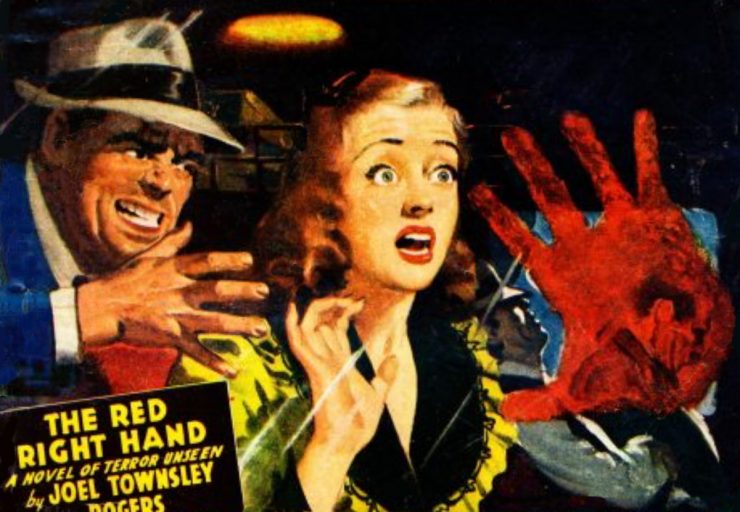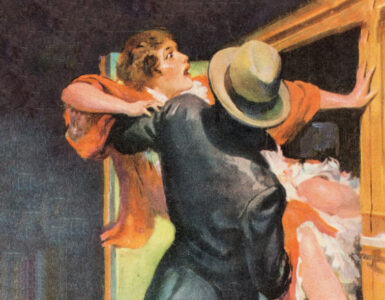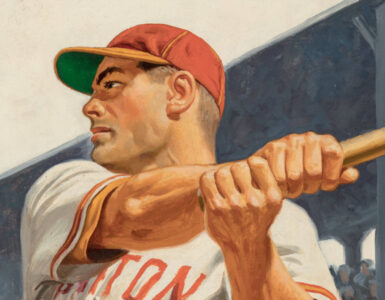Pulp magazines have influenced writers, artists, film directors, software developers, and countless others over the years. Our “PulpFest History” articles focus on the rough-paper writers, editors, publishers, and artists who have inspired and continue to inspire the creators of the world’s popular culture.
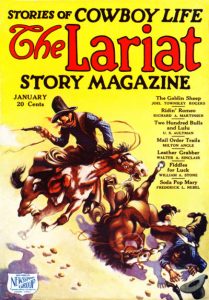 Best remembered for The Red Right Hand, considered to be one of the finest mystery novels of the 20th century, Joel Townsley Rogers was born in Sedalia, Missouri on November 22, 1896. According to his son’s bibliography of the author, he decided to become a writer as a teenager.
Best remembered for The Red Right Hand, considered to be one of the finest mystery novels of the 20th century, Joel Townsley Rogers was born in Sedalia, Missouri on November 22, 1896. According to his son’s bibliography of the author, he decided to become a writer as a teenager.
Rogers studied English and the Humanities at Harvard University. With the United States about to enter the First World War, Rogers left college to enlist. “He joined the navy air corps and became one of its first few hundred flyers. He went through training in Hampton Roads, Virginia, and though he was aching to go overseas . . . he was sent to Pensacola as a flight instructor. The planes he flew and taught others to fly were tiny pontooned biplanes made of spruce and linen. After the war, he made use of his experiences and vivid imagination to sell short stories to the raft of pulp magazines that sold in the 1920s and 1930s for fifteen or twenty cents.”
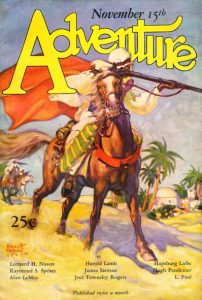 Joel Townsley Rogers’ first pulp sale was “The Battle Cruiser Lady.” Published under a pseudonym, it was a vignette that appeared in the second number of the February 1920 Snappy Stories, a predecessor of the girlie pulps. Rogers quickly established himself as a regular with Snappy Stories and similar magazines — Saucy Stories, Telling Tales, and Zest — before breaking into the general fiction pulps. In 1922, he placed stories with Top-Notch Magazine and Adventure. Four years later, he sold a pair of western novellas to Fiction House and soon became a regular contributor to the publisher’s line of pulp magazines.
Joel Townsley Rogers’ first pulp sale was “The Battle Cruiser Lady.” Published under a pseudonym, it was a vignette that appeared in the second number of the February 1920 Snappy Stories, a predecessor of the girlie pulps. Rogers quickly established himself as a regular with Snappy Stories and similar magazines — Saucy Stories, Telling Tales, and Zest — before breaking into the general fiction pulps. In 1922, he placed stories with Top-Notch Magazine and Adventure. Four years later, he sold a pair of western novellas to Fiction House and soon became a regular contributor to the publisher’s line of pulp magazines.
Although he would continue to spin an occasional western or adventure yarn for his new market, the bulk of Joel Townsley Rogers sales to Fiction House would be aviation or air war stories.
It was J. Q. Glenister’s and John B. Kelly’s Fiction House that introduced the air pulp to American newsstands. Spurred on by the heroic flight of Charles A. Lindbergh, the exotic lifestyles of gypsy barnstormers, the contrived escapades of flying circuses, and the sense of wonder surrounding manned flight itself, the air pulps proved an immediate hit. The first of them, Fiction House’s Air Stories, debuted with its August 1927 issue. It was joined soon thereafter by a host of similar magazines from a variety of publishers — Dell’s War Birds and Sky Riders, Clayton’s Air Adventurers, Street & Smith’s Air Trails, Ace’s Sky Birds and Flying Aces, Hersey’s Flying Stories, Ramer’s Zeppelin Stories, and others. Fiction House likewise copied its own success with two more aviation titles — Wings and Aces.
During the late 1920s and early thirties, Fiction House had an air pulp coming out every ten days — Air Stories on the first, Wings on the 10th, and Aces on the 20th. With that sort of line-up, Glenister and Kelly required a stable of regular and dependable writers who knew their stuff. Given his experiences as a flight instructor during World War I, Joel Townsley Rogers was armed and ready.
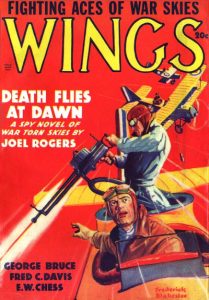 Although his first three aviation stories appeared in Air Stories, it was in Wings and Aces that Rogers would really make his mark. According to the late EC Comics artist and aviation buff, George Evans:
Although his first three aviation stories appeared in Air Stories, it was in Wings and Aces that Rogers would really make his mark. According to the late EC Comics artist and aviation buff, George Evans:
“Rogers was a great writer who developed a far wider picture of World War I — ground, sea, and air — than most of the air-pulp authors. Virtually everything that he produced was different, intriguingly plotted, well-researched, and characterized. I’d place his story, “The Firebirds” (Wings for October 1934), at the top of any air stuff I’ve read, and tale after tale that he did for Wings and Aces on a “top ten” list.
In addition to his work for Fiction House, Joel Townsley Rogers also contributed air fiction to Air Trails, Dare-Devil Aces, Everybody’s Magazine, War Aces, and other pulps. However, from the beginning of 1930 until mid-1938, the bulk of his work was for Fiction House’s Aces and Wings. During that period he produced one serial, 25 novellas and novelettes, and seven short stories for the two magazines. He also wrote seven flying stories for the publisher’s Action Novels and Air Stories, as well as a handful of stories for Wings during its last decade.
Although Rogers continued writing for most of his life, he never matched his output for the World War I issues of Aces and Wings.
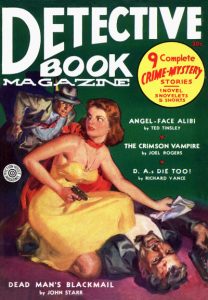 While he was producing reams of air-war stories for Fiction House, Joel Townsley Rogers began to delve into the mystery field, beginning with the short novel, “Murder of the Dead Man,” published in the July 28, 1934 number of Munsey’s Detective Fiction Weekly. Over the next seven years, he produced a handful of mystery serials and novellas for the same magazine, as well as stories for All-American Fiction, Argosy, Two-Book Detective Magazine, and Fiction House’s Detective Book Magazine. Beginning in 1945, the mystery and detective field would become the author’s primary market, with most of his sales going to Popular Publications’ Detective Tales and New Detective Magazine. It was in the latter where his suspense classic, “The Red Right Hand,” would first appear as a short novel. It would be expanded for book publication in 1945 as part of Simon and Schuster’s Inner Sanctum Mystery series.
While he was producing reams of air-war stories for Fiction House, Joel Townsley Rogers began to delve into the mystery field, beginning with the short novel, “Murder of the Dead Man,” published in the July 28, 1934 number of Munsey’s Detective Fiction Weekly. Over the next seven years, he produced a handful of mystery serials and novellas for the same magazine, as well as stories for All-American Fiction, Argosy, Two-Book Detective Magazine, and Fiction House’s Detective Book Magazine. Beginning in 1945, the mystery and detective field would become the author’s primary market, with most of his sales going to Popular Publications’ Detective Tales and New Detective Magazine. It was in the latter where his suspense classic, “The Red Right Hand,” would first appear as a short novel. It would be expanded for book publication in 1945 as part of Simon and Schuster’s Inner Sanctum Mystery series.
The author would also produce a smattering of fantasy and science fiction, including “Beyond Space and Time” — for All-American Fiction and selected by Anthony Boucher for his anthology, A Treasury of Great Science Fiction, published by Doubleday in 1959 — and “No Matter Where You Go,” reprinted in The Best from Fantasy and Science Fiction, Ninth Series, edited by Robert P. Mills. He’d also sell three short stories to The Saturday Evening Post.
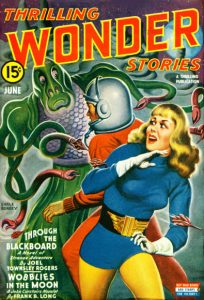 In a letter to a Mr. Vreeland, written by Joel Townsley Rogers in 1962:
In a letter to a Mr. Vreeland, written by Joel Townsley Rogers in 1962:
“How did I come to write stories? In college, I’d done poetry and editorials and stories and articles for the college magazines. In the fall of 1919, fresh from the service, jobs were scarce, and so I began writing. For absurd magazines called Snappy Stories and the like. Better than working at a job, I thought. For three years I wrote a little book-review magazine in New York and became a kind of pundit. . . . But I didn’t stay, because I’d got married, and the job didn’t pay enough. So I began writing reams and reams of imaginary war flying stories, for swarms of magazines which were popular at the time. And when the magazines died away, it was too late for me to get an honest job. In fact, if one says one has been a fiction writer, it is like saying one has been a strip-tease artist. You may have a brain, but it is doubtful.”
Joel Townsley Rogers died in 1984.
Although Joel Townsley Rogers primarily wrote air war stories for Fiction House, his first two stories for the publisher were both western novellas. “The Goblin Sheep” ran in the January 1926 number of The Lariat Story Magazine — featuring a cover by Elliott Dold — while “Beyond the Bitter River” appeared in Action Stories for August 1926.
After he got his start in Snappy Stories, Rogers began to contribute to the general fiction pulps, including Adventure. Between 1922 and 1945, he contributed nine stories to the magazine, including the November 15, 1927 number, featuring a cover by Emmett Watson.
From the beginning of 1930 until mid-1938, the bulk of Rogers’ work was written for Fiction House’s Wings and Aces. “Death Flies at Dawn” appeared in the Fall 1936 Wings, with cover art by Frederick Blakeslee. Interestingly, the artist’s cover painting was used originally on the February 1931 Aces. Blakeslee is best remembered for his cover paintings for the Popular Publications hero pulp, G-8 and His Battle Aces.
While he was producing reams of air-war stories for Fiction House, Joel Townsley Rogers also began to delve into the mystery field, beginning in 1934. Through 1941, the primary market for his mystery fiction was Munsey’s Detective Fiction Weekly. He did, however, contribute one short story, “The Crimson Vampire,” to Fiction House’s Detective Book Magazine. Appearing in the pulp’s Spring 1938 number, it featured a cover by Norman Saunders.
No “one-trick pony,” Joel Townsley Rogers also produced a smattering of fantasy and science fiction, beginning with “Hark! The Rattle!” a short story published in the first issue of Weird Tales. His novella, “Through the Blackboard,” ran in Thrilling Wonder Stories for June 1943, with cover art by Earle K. Bergey. Billed as “A Short Novel of Strange Adventure,” Rogers’ story concerns the adventures of a mathematics professor as he penetrates the fourth dimension.
To learn more about Joel Townsley Rogers, we recommend “The Red Right Hand of Joel Townsley Rogers,” an article by Al Lybeck for Pulpdom #5, published in July 1997 by Camille Cazedessus. There’s also quite a bit about the author in Purple Prose #15, published in 2002 by Michael Chomko. That’s where you’ll find George Evans’ quote on the author, as well as a look at Wings, written by Chomko and the late Steve Young. “Fighting Aces of War Skies” can also be found in the eighteenth issue of Windy City Pulp Stories, published in 2018. Terence E. Hanley also has a nice write-up on the author at his Tellers of Weird Tales website.
Finally, to read some of the author’s short crime and mystery fiction, we recommend Night of Horror and Other Stories and Killing Time and Other Stories, both published by Ramble House. For ordering information, write to mike@pulpfest.com.
Michael Chomko, the winner of the 2010 Munsey Award, is the marketing and programming director for PulpFest. A registered nurse, Mike sells books on a part-time basis, operating as Mike Chomko, Books. His specialty is pulp-related material.

